Optimization of Ecological and Economic Aspects of the Construction Schedule with the Use of Metaheuristic Algorithms and Artificial Intelligence
Abstract
:1. Introduction
2. Materials and Methods
2.1. Schedule Optimization Models
- the problem of project scheduling without taking into account resource constraints (Unconstrained Project Scheduling Problem, UPSP),
- problem of project scheduling taking into account resource constraints (Resource- Constrained Project Scheduling Problem, RCPSP),
- the problem of project scheduling, taking into account resource constraints and different modes (variants/ways) of performing activities (Multi-Mode Resource Constrained Project Scheduling Problem, MMRCPSP, or MRCPSP).
2.2. Sustainability Value Index
2.3. Optimization Model
- Equation (6)—this part of the objective function is focused on optimizing the relative NPV value, with and being (respectively) the maximum and minimum NPV values found during UPS phase. The NPV is a measure of the profitability of the project, taking into account the time value of money. By optimizing this value, the objective function aims to improve the financial performance of the project.
- represents the profits for the period ending on h, h = 1, 2, …, H.
- represents the indirect costs for the same period h, h = 1, 2, …, H.
- TI is a fixed time interval, in this case, one working month expressed in days.
- is a variable used to model payment delays expressed in working days , and calculated as .
- is cash flow of activity when performed in mode .
- is the interest rate (used for NPV calculation).
- represents a date after which contractual penalties are being charged.
- Equation (7)—this part of the objective function is focused on optimizing the relative SVI value, with and being (respectively) the maximum and minimum SVI values found during the UPS phase. The SVI is a measure of the sustainability of a construction project, taking into account various factors such as energy efficiency, durability, and environmental impact.
- is the SVI value for activity performed in mode .
- Equation (8) is the penalty component ensuring that each month the cash flow does not exceed the set limit .
- Equation (9) is the penalty component corresponding to the limits of renewable and non-renewable (and also doubly constrained) resources.
- Equation (10) introduces a binary variable, T, which ensures that the construction is carried out in a technologically consistent manner. This means that the selection of a particular mode for some activities may exclude certain modes for other activities.
- Equation (11) introduces a deadline for construction completion , .
- Equation (12) requires that each activity is completed only once and in a single defined mode.
- Equation (13) describes the relations between tasks.
- Equation (14) models binary decision variables.
2.4. Optimization Procedure
3. Results
3.1. Case Study
3.1.1. Basic Information
- building area: 160.60 m2,
- usable area: 153.20 m2,
- area of the garage and utility part: 38.80 m2,
- net area: 220.00 m2,
- gross volume: 650.00 m3,
- number of above-ground levels: 1 + usable attic,
- basement: none,
- heating: local,
- the groundwater level below the foundations.
3.1.2. SVI Analysis
3.1.3. Updating the Schedule
3.1.4. UPS Optimization
3.1.5. MRCPS Optimization and AMTANN Procedure
3.1.6. Project Selection
3.2. Additional Tests
4. Discussion
5. Conclusions
- It is possible to improve the sustainable parameters of a construction object by using appropriate methods and algorithms.
- It is possible to model the construction schedule and to select the mode of the project most adequate to the formulated expectations of decision makers.
- It is possible to reconcile the ecological and economical aspects of construction project optimization with the use of artificial intelligence tools.
- Artificial neural networks can be effectively utilized to enhance the performance of metaheuristic algorithms and improve the outcomes of construction projects.
Author Contributions
Funding
Institutional Review Board Statement
Informed Consent Statement
Data Availability Statement
Conflicts of Interest
Abbreviations
| List of abbreviations used in the article (in alphabetical order). | |
| AMTANN | Approach for MRCPSP Transformation with the use of Artificial Neural Networks |
| ANN | Artificial Neural Networks |
| CIB | Conseil International du Bâtiment, ang. International Council for Building |
| CIOB | Chartered Institute of Building |
| ICC | International Code Council |
| ISO | International Organization for Standardization |
| LCC | Life Cycle Cost |
| MRCPSP/MMRCPSP | Multi-Mode Resource-Constrained Project Scheduling Problem |
| MRCPSPDCF | MRCPSP with Discounted Cash Flows |
| MRC-TCT/RC-TCT/TCT | Multi-Mode Resource-Constrained Time—Cost Trade-off |
| NPV | Net Present Value |
| RCPS | Resource-Constrained Project Scheduling |
| RCPSP | Resource-Constrained Project Scheduling Problem |
| SVI | Sustainable Value Index |
| TCT | Time—Cost Trade-off |
| TS | Tabu Search |
| UPS | Unconstrained Project Scheduling |
| UPSP | Unconstrained Project Scheduling Problem |
| VE | Value Engineering |
| VM | Value Management |
References
- Böde, K.; Różycka, A.; Nowak, P. Development of a Pragmatic IT Concept for a Construction Company. Sustainability 2020, 12, 7142. [Google Scholar] [CrossRef]
- Hostetler, M. Beyond design: The importance of construction and post-construction phases in green developments. Sustainability 2010, 2, 1128–1137. [Google Scholar] [CrossRef] [Green Version]
- Ibadov, N.; Kulejewski, J.; Krzemiński, M. Fuzzy ordering of the factors affecting the implementation of construction projects in Poland. In AIP Conference Proceedings; American Institute of Physics: College Park, MD, USA, 2013; Volume 1558, pp. 1298–1301. [Google Scholar]
- Rosłon, J.; Książek-Nowak, M.; Nowak, P.; Zawistowski, J. Cash-flow schedules optimization within life cycle costing (LCC). Sustainability 2020, 12, 8201. [Google Scholar] [CrossRef]
- Sobieraj, J.; Metelski, D.; Nowak, P. PMBoK vs. PRINCE2 in the context of Polish construction projects: Structural Equation Modelling approach. Arch. Civ. Eng. 2021, 67, 551–579. [Google Scholar]
- Sobieraj, J.; Metelski, D. Project Risk in the Context of Construction Schedules—Combined Monte Carlo Simulation and Time at Risk (TaR) Approach: Insights from the Fort Bema Housing Estate Complex. Appl. Sci. 2022, 12, 1044. [Google Scholar] [CrossRef]
- Yepes, V.; García-Segura, T. (Eds.) Sustainable Construction; MDPI: Basel, Switzerland, 2021; ISBN 978-3-0365-0483-4. [Google Scholar]
- Kim, J.; Koo, C.; Kim, C.J.; Hong, T.; Park, H.S. Integrated CO2, cost, and schedule management system for building construction projects using the earned value management theory. J. Clean. Prod. 2015, 103, 275–285. [Google Scholar] [CrossRef]
- Leśniak, A.; Zima, K. Cost calculation of construction projects including sustainability factors using the Case Based Reasoning (CBR) method. Sustainability 2018, 10, 1608. [Google Scholar] [CrossRef] [Green Version]
- Nicał, A.; Anysz, H. The quality management in precast concrete production and delivery processes supported by association analysis. Int. J. Environ. Sci. Technol. 2020, 17, 577–590. [Google Scholar] [CrossRef]
- Sobieraj, J. Impact of spatial planning on the pre-investment phase of the development process in the residential construction field. Arch. Civ. Eng. 2017, 63, 113–130. [Google Scholar] [CrossRef] [Green Version]
- Kulejewski, J. Construction project scheduling with imprecisely defined constraints. In Proceedings of the Management and Innovation for a Sustainable Built Environment MISBE 2011, Amsterdam, The Netherlands, 20–23 June 2011; CIB, Working Commissions W55, W65, W89, W112; ENHR and AESP. CIB: Amsterdam, Netherlands, 2011. [Google Scholar]
- Meredith, J.R.; Shafer, S.M.; Mantel, S.J., Jr. Project Management: A Strategic Managerial Approach; John Wiley & Sons: Hoboken, NJ, USA, 2017. [Google Scholar]
- Rosłon, J.; Zawistowski, J. Construction projects’ indicators improvement using selected metaheuristic algorithms. Procedia Eng. 2016, 153, 595–598. [Google Scholar] [CrossRef] [Green Version]
- Rosłon, J.; Książek-Nowak, M.; Nowak, P. Schedules Optimization with the Use of Value Engineering and NPV Maximization. Sustainability 2020, 12, 7454. [Google Scholar] [CrossRef]
- Rosłon, J.H.; Kulejewski, J.E. A hybrid approach for solving multi-mode resource-constrained project scheduling problem in construction. Open Eng. 2019, 9, 7–13. [Google Scholar] [CrossRef]
- Krzemiński, M. Conctruction scheduling and stability of the resulting schedules. Arch. Civ. Eng. 2016, 62, 89–100. [Google Scholar] [CrossRef] [Green Version]
- Podolski, M.; Rosłon, J.; Sroka, B. The Impact of the Learning and Forgetting Effect on the Cost of a Multi-Unit Construction Project with the Use of the Simulated Annealing Algorithm. Appl. Sci. 2022, 12, 12667. [Google Scholar] [CrossRef]
- Sroka, B.; Rosłon, J.; Podolski, M.; Bożejko, W.; Burduk, A.; Wodecki, M. Profit optimization for multi-mode repetitive construction project with cash flows using metaheuristics. Arch. Civ. Mech. Eng. 2021, 21, 1–17. [Google Scholar] [CrossRef]
- Habibi, F.; Barzinpour, F.; Sadjadi, S. Resource-constrained project scheduling problem: Review of past and recent developments. J. Proj. Manag. 2018, 3, 55–88. [Google Scholar] [CrossRef]
- Kolisch, R.; Sprecher, A. PSPLIB-a project scheduling problem library: OR software-ORSEP operations research software exchange program. Eur. J. Oper. Res. 1997, 96, 205–216. [Google Scholar] [CrossRef] [Green Version]
- Van Peteghem, V.; Vanhoucke, M. An experimental investigation of metaheuristics for the multi-mode resource-constrained project scheduling problem on new dataset instances. Eur. J. Oper. Res. 2014, 235, 62–72. [Google Scholar] [CrossRef]
- Giunta, M. Assessment of the Impact of CO, NOx and PM10 on Air Quality during Road Construction and Operation Phases. Sustainability 2020, 12, 10549. [Google Scholar] [CrossRef]
- Giunta, M.; Lo Bosco, D.; Leonardi, G.; Scopelliti, F. Estimation of Gas and Dust Emissions in Construction Sites of a Motorway Project. Sustainability 2019, 11, 7218. [Google Scholar] [CrossRef] [Green Version]
- Hime, N.J.; Marks, G.B.; Cowie, C.T. A Comparison of the Health Effects of Ambient Particulate Matter Air Pollution from Five Emission Sources. Int. J. Environ. Res. Public Health 2018, 15, 1206. [Google Scholar] [CrossRef] [PubMed]
- Böhringer, C.; Jochem, P.E. Measuring the immeasurable—A survey of sustainability indices. Ecol. Econ. 2007, 63, 1–8. [Google Scholar] [CrossRef] [Green Version]
- Batista, A.A.D.S.; Francisco, A.C.D. Organizational sustainability practices: A study of the firms listed by the corporate sustainability index. Sustainability 2018, 10, 226. [Google Scholar] [CrossRef] [Green Version]
- Rosłon, J. Materials and Technology Selection for Construction Projects Supported with the Use of Artificial Intelligence. Materials 2022, 15, 1282. [Google Scholar] [CrossRef]
- Lin, G.; Shen, Q. Measuring the performance of value management studies in construction: Critical review. J. Manag. Eng. 2007, 23, 2–9. [Google Scholar] [CrossRef]
- Pritsker, A.A.B.; Waiters, L.J.; Wolfe, P.M. Multiproject scheduling with limited resources: A zero-one programming approach. Manag. Sci. 1969, 16, 93–108. [Google Scholar] [CrossRef] [Green Version]
- Ratajczak-Ropel, E. Multi-mode Resource-Constrained Project Scheduling. In Population-Based Approaches to the Resource-Constrained and Discrete-Continuous Scheduling; Springer: Cham, Switzerland, 2018; pp. 69–97. [Google Scholar]
- Talbot, F.B. Resource-constrained project scheduling with time-resource tradeoffs: The nonpreemptive case. Manag. Sci. 1982, 28, 1197–1210. [Google Scholar] [CrossRef]
- Książek, M.V.; Nowak, P.O.; Kivrak, S.; Rosłon, J.H.; Ustinovichius, L. Computer-aided decision-making in construction project development. J. Civ. Eng. Manag. 2015, 21, 248–259. [Google Scholar] [CrossRef]
- Sekocenbud. Biuletyn cen obiektów budowlanych BCO, część I—obiekty kubaturowe, II kwartał 2018 r; Ośrodek Wdrożeń Ekonomiczno-Organizacyjnych Budownictwa „PROMOCJA” Sp. z o.o.: Otwock, Poland, 2018. [Google Scholar]
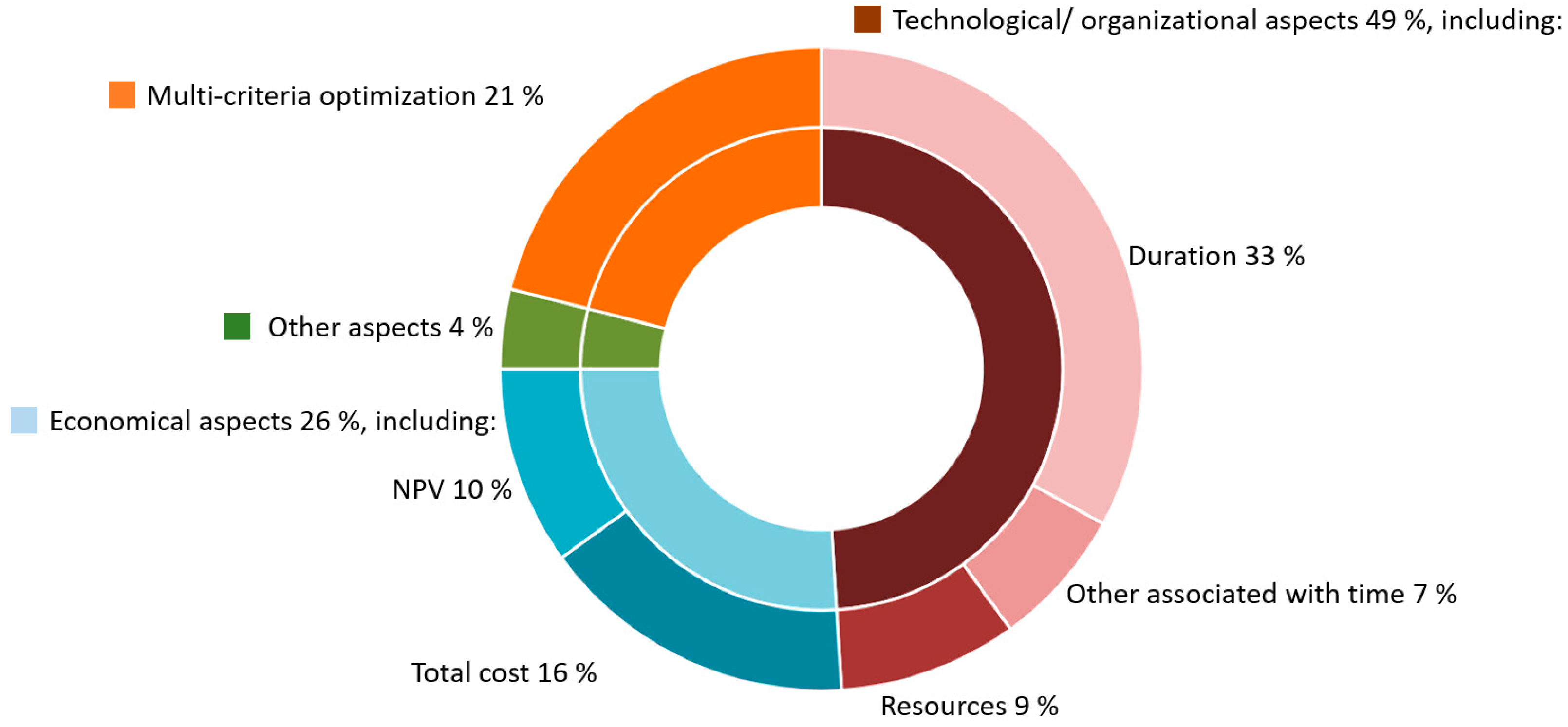


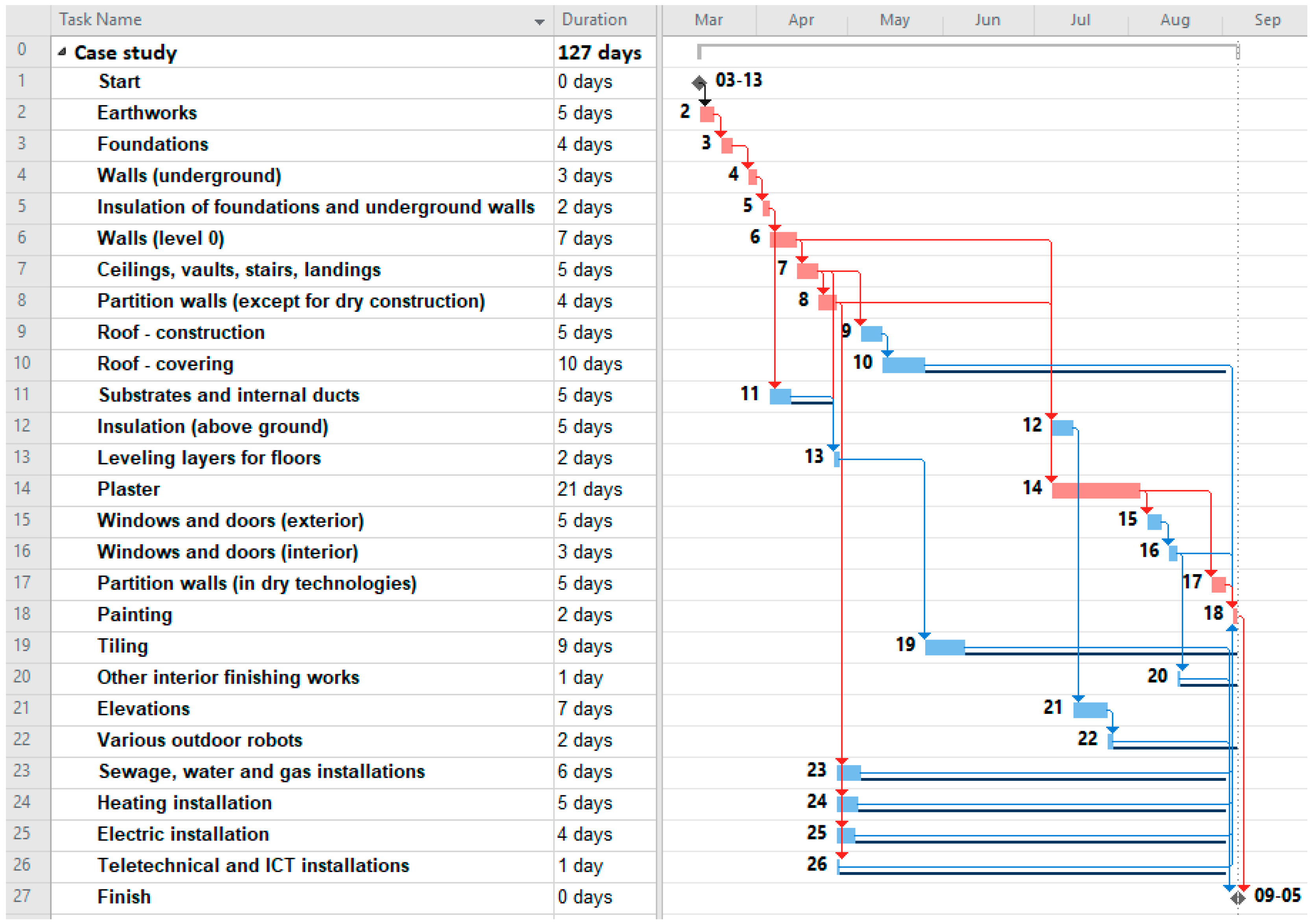
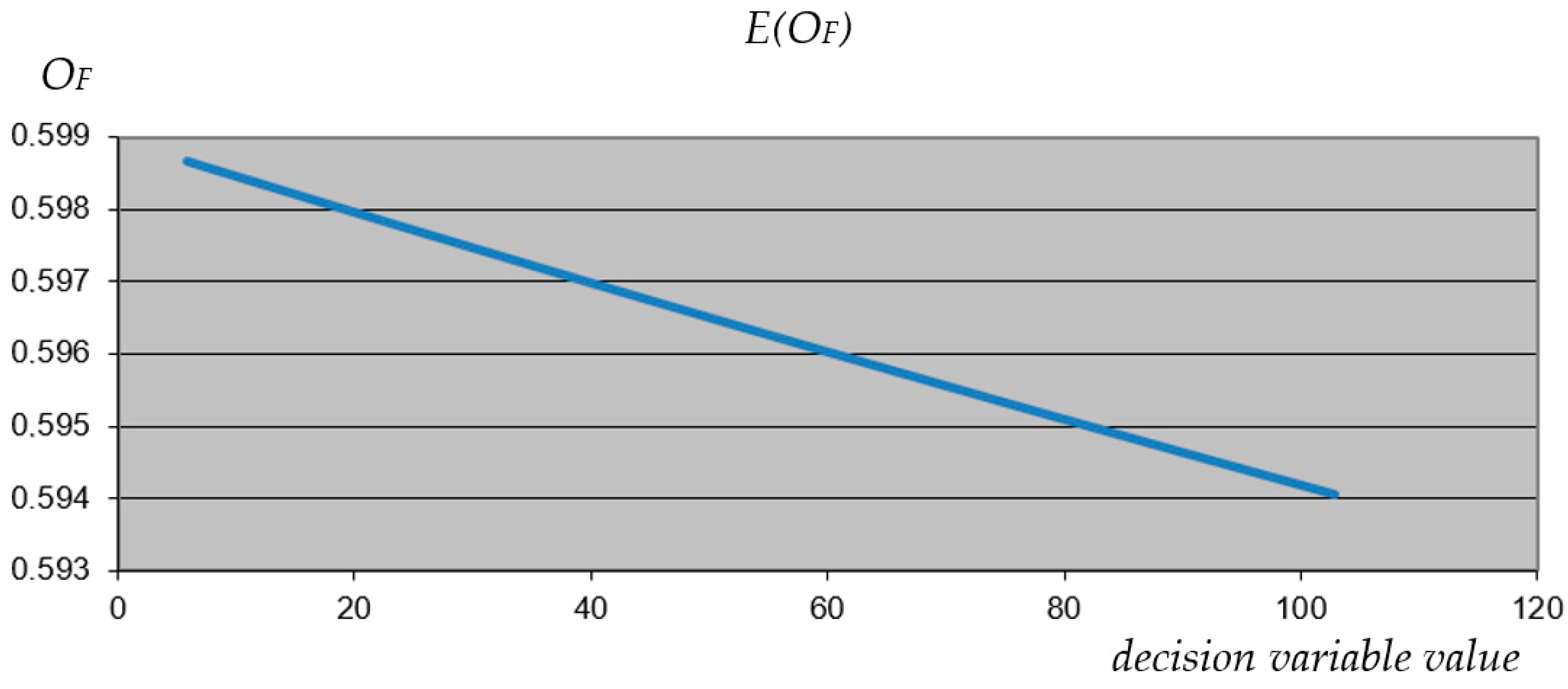
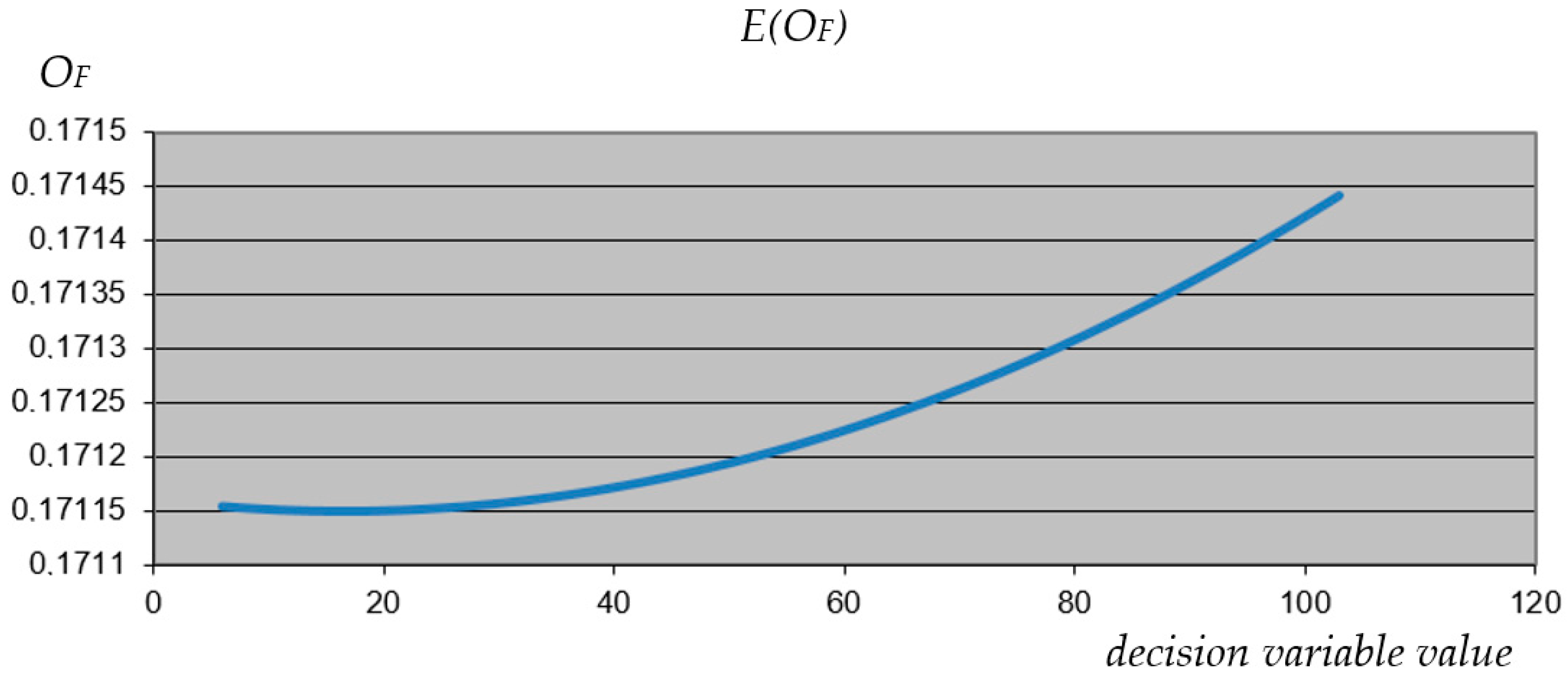


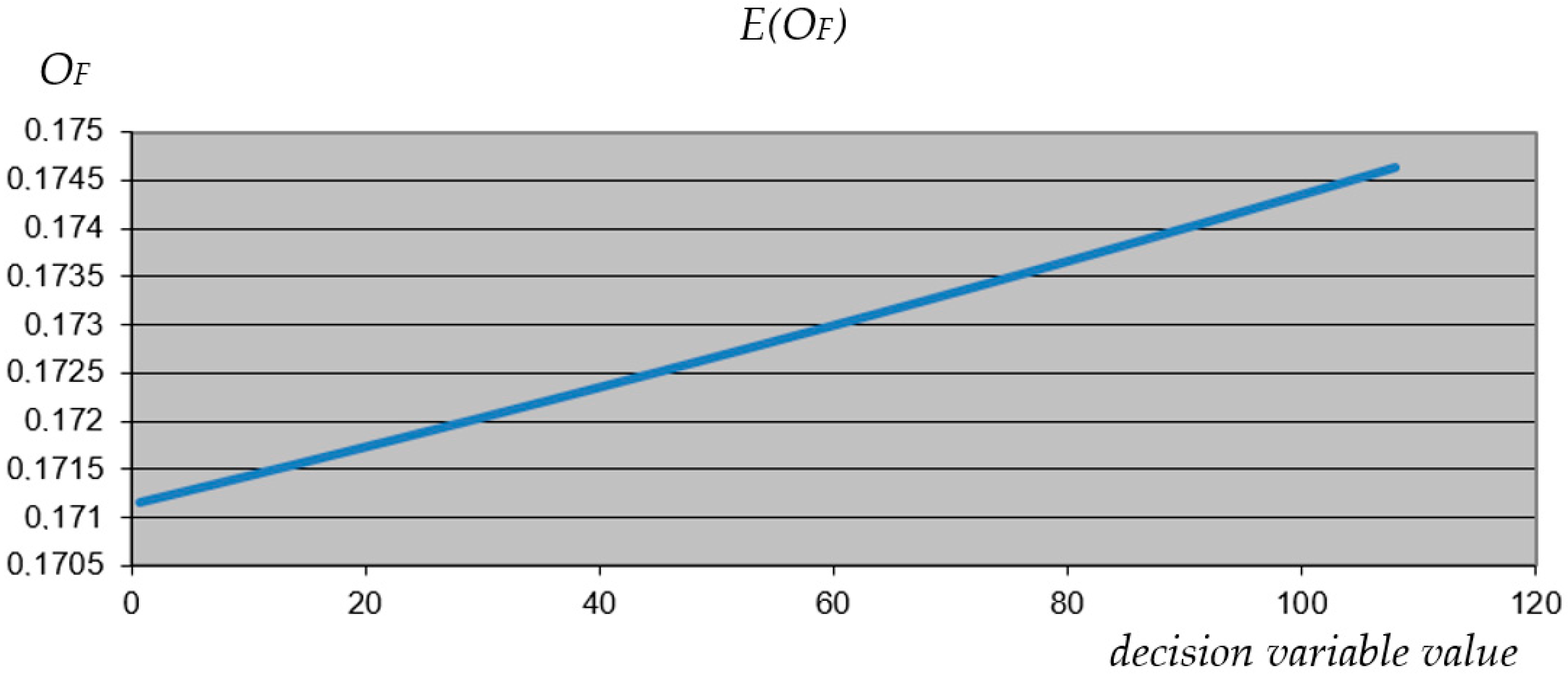
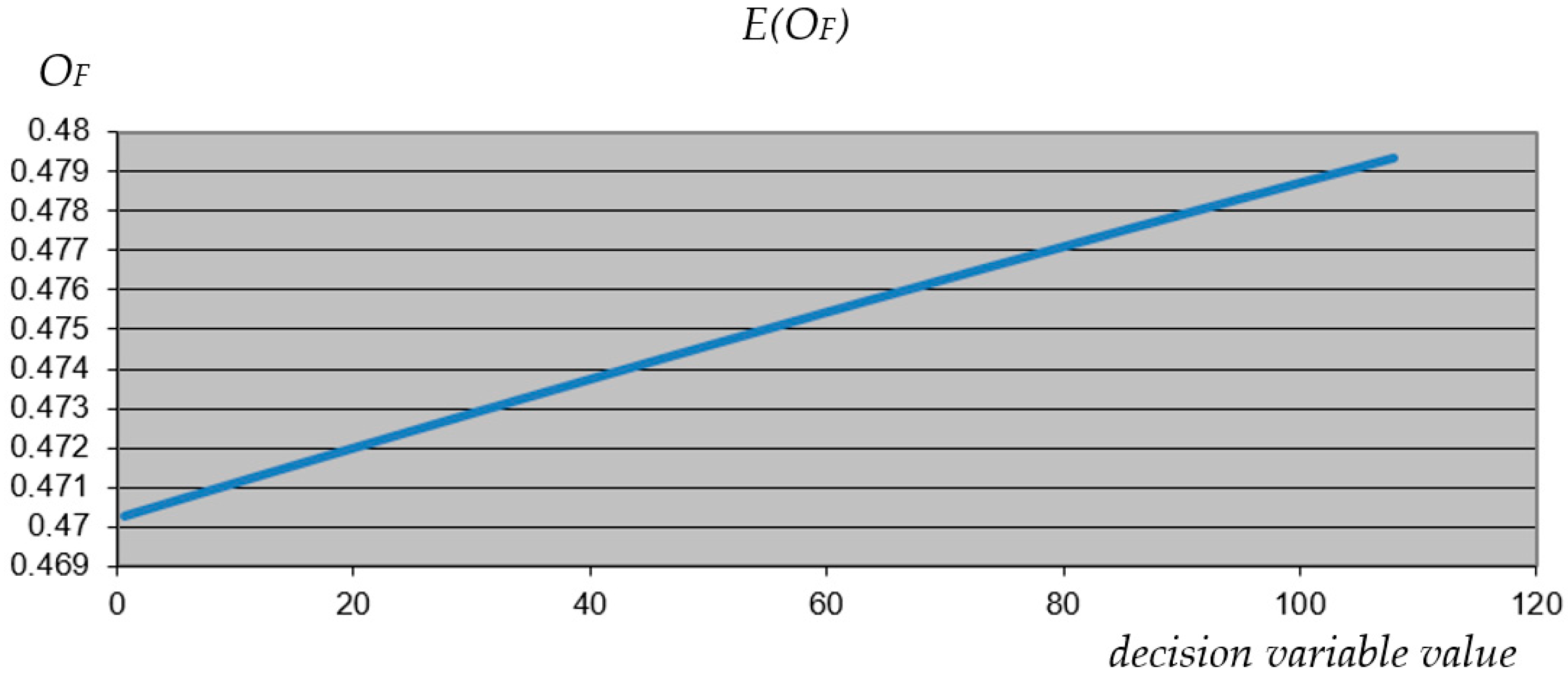
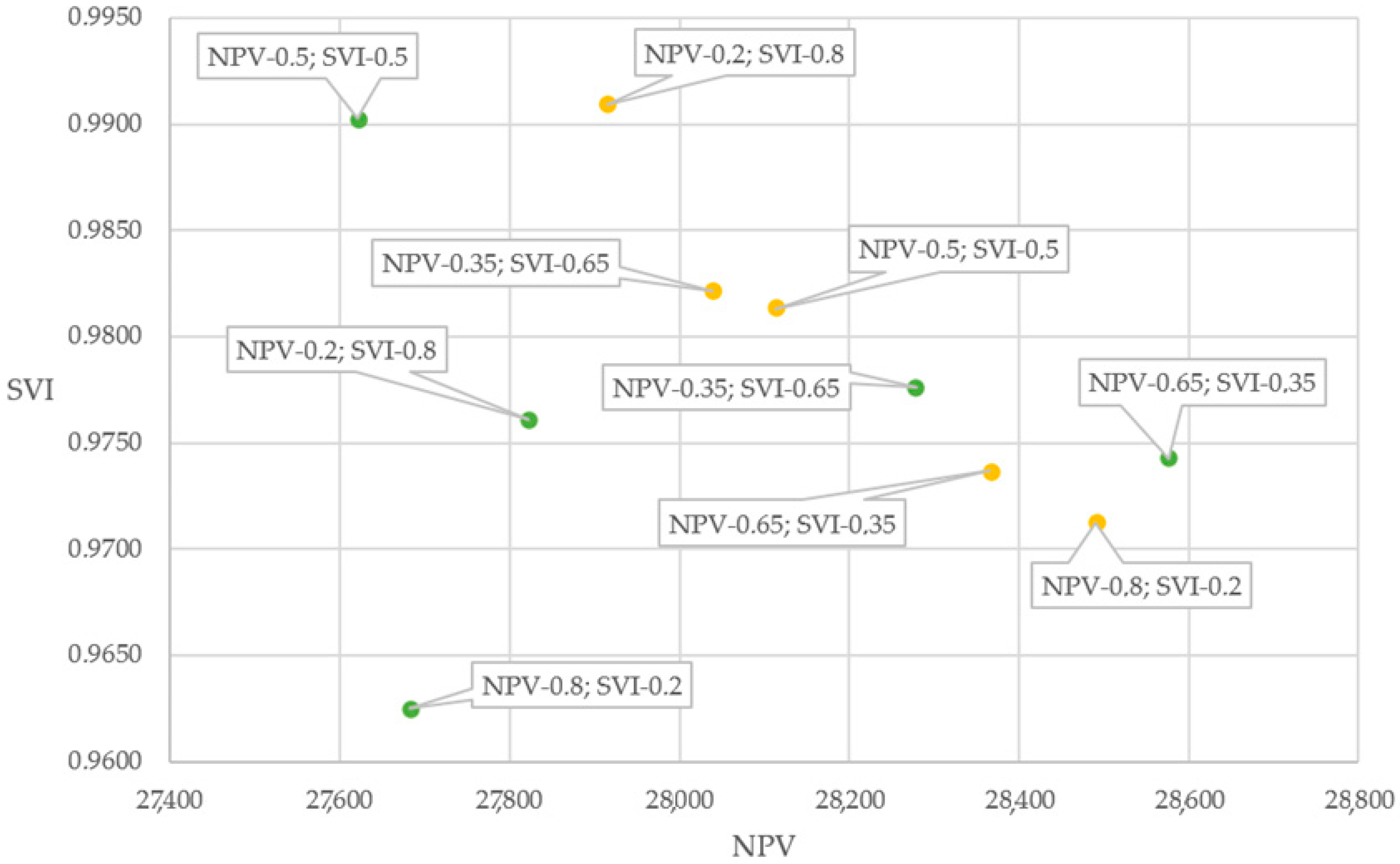

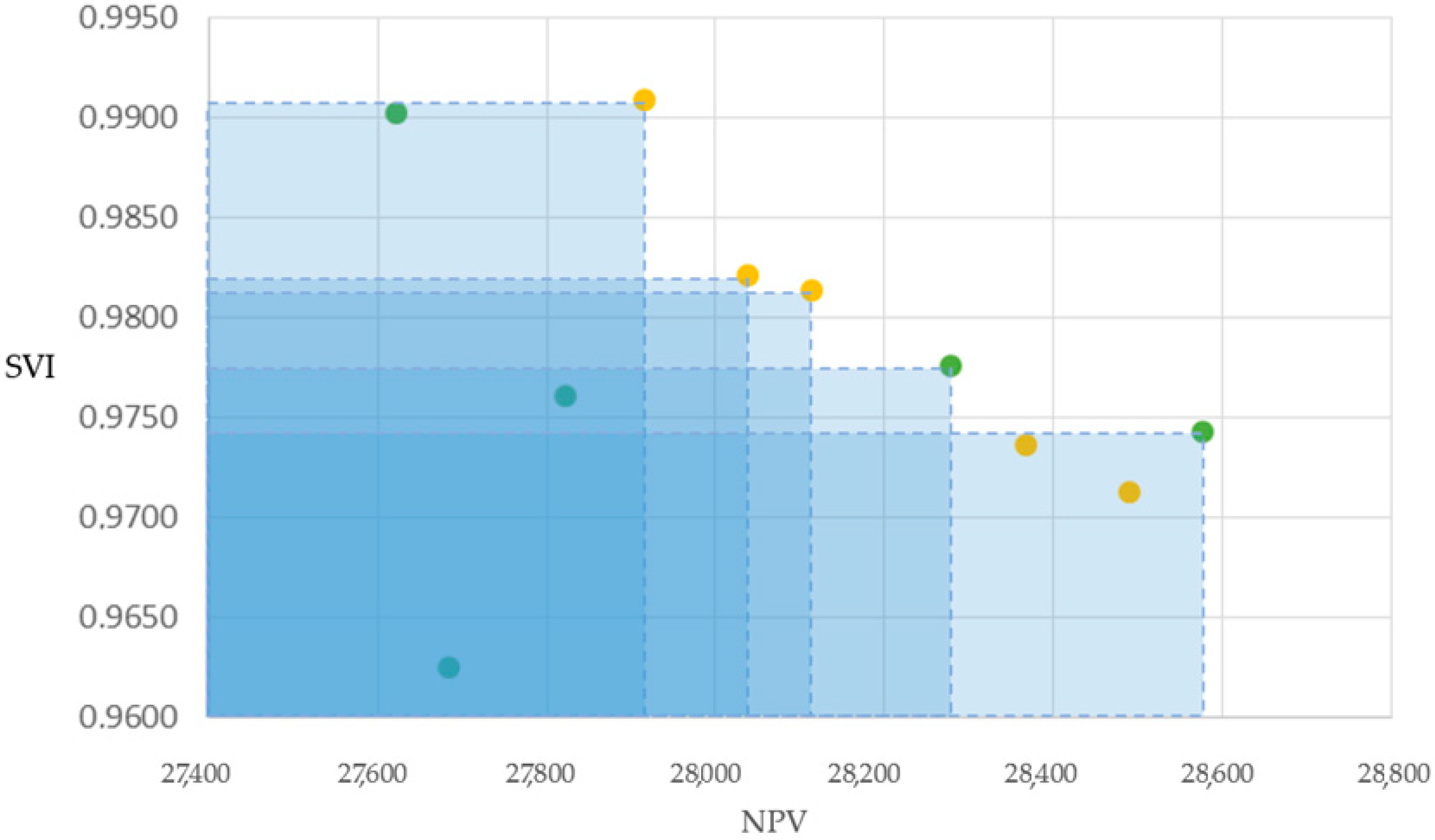
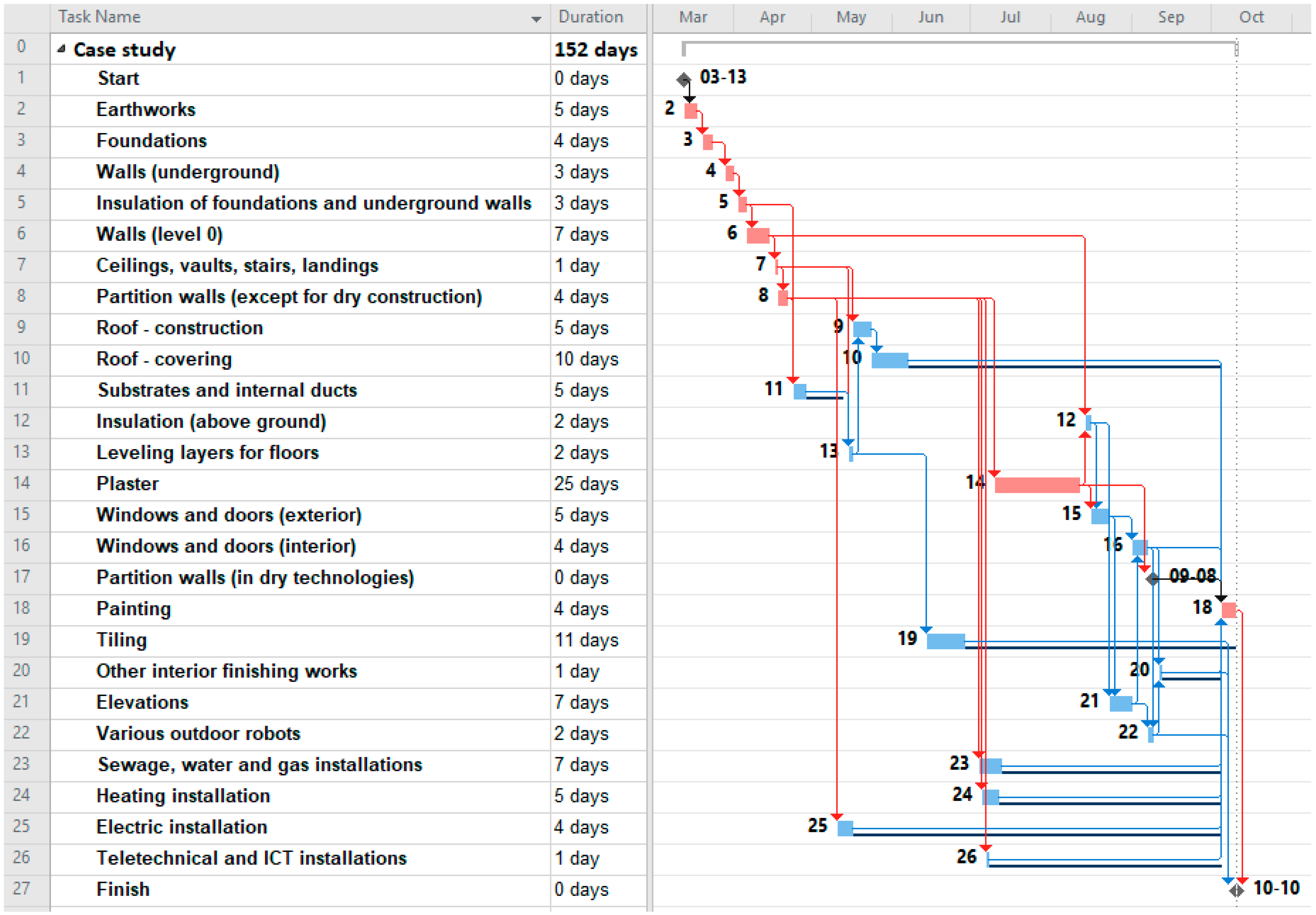
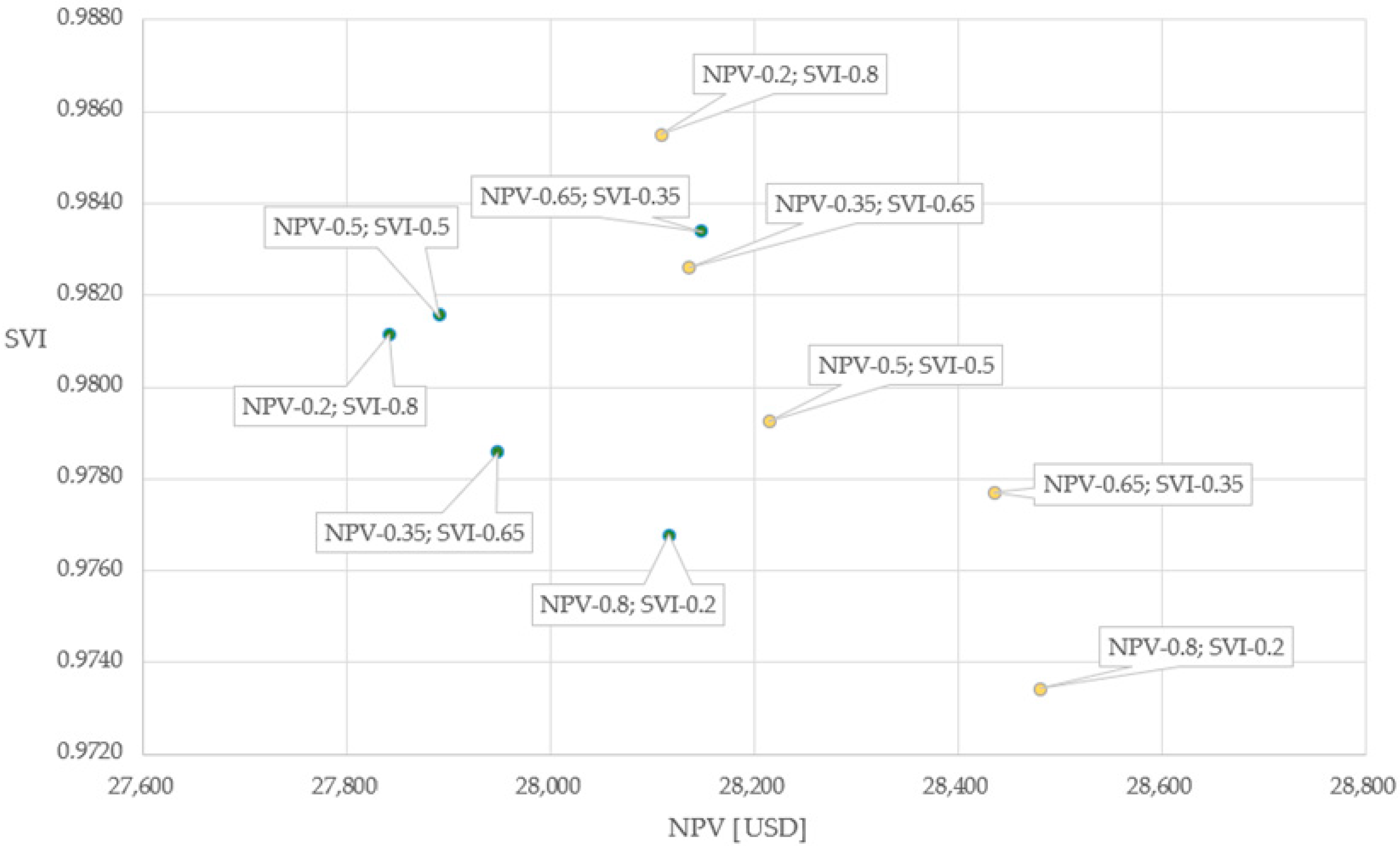
| 1. Sustainability | 1.1. Recycling and utilization |
| 1.2. Greenhouse gas emissions | |
| 1.3. Economics (operational costs) | |
| 1.4. Energy saving | |
| 1.5. Durability | |
| 2. User health and safety | 2.1. Air quality |
| 2.2. Water supply and other utilities | |
| 2.3. Waste disposal | |
| 3. User comfort | 3.1. Acoustic comfort |
| 3.2. Lighting (visual comfort) | |
| 3.3. Hygrothermal comfort | |
| 3.4. Serviceability |
| Task | Variant 1 | Variant 2 | Variant 3 | Variant 4 | Variant 5 | |
|---|---|---|---|---|---|---|
| ID | Name | Description | Description | Description | Description | Description |
| 1 | Start | - | - | - | - | - |
| 2 | Earthworks | excavation (soil category III, groundwater level below the foundation level) | - | - | - | - |
| 3 | Foundations | monolithic, reinforced concrete | concrete blocks | brick | - | - |
| 4 | Walls (underground) | concrete blocks panels in layers and solid bricks with polystyrene thermal insulation | concrete blocks panels in layers and solid bricks with polystyrene thermal insulation; from the ground level, a pressure layer made of full clinker brick * | lime-sand blocks with thermal insulation made of mineral wool | - | - |
| 5 | Insulation of foundations and underground walls | anti-moisture (bitumen) | foil | - | - | - |
| 6 | Walls (level 0) | external: layered with checkered and cellular concrete and polystyrene tiles, internal structural: solid brick; binders and columns: monolithic—reinforced concrete | external: layered with checkerboard and polystyrene, with saturated wood filled with full construction brick (“timber framing”); internal structural: full brick; binders and columns: monolithic—reinforced concrete ** | external: layered with concrete blocks and polystyrene, with saturated wood filled with full construction brick, (“timber framing”); internal structural: full brick; binders and columns: monolithic—reinforced concrete * | external: SILKA and Styrofoam internal structural: SILKA; binders and columns: monolithic—reinforced concrete | external: Porotherm I Styrofoam internal structural: Porotherm; binders and columns: monolithic—reinforced concrete |
| 7 | Ceilings, vaults, stairs, landings | Teriva ceilings; monolithic reinforced concrete stairs | Smart ceilings; monolithic reinforced concrete stairs | ACKERMAN ceilings; monolithic reinforced concrete stairs | YTONG ceilings; monolithic reinforced concrete stairs | Filigran ceilings; monolithic reinforced concrete stairs |
| 8 | Partition walls (except for dry construction) | perforated brick *** | Silka *** | Porotherm *** | solbet (all) **** | ytong (all) **** |
| 9 | Roof—construction | wooden truss | - | - | - | - |
| 10 | Roof—covering | galvanized trapezoidal sheet; insulation: mineral wool | ceramic tile; insulation: mineral wool | bitumen tile; insulation: mineral wool; sheet metal finishes | - | - |
| 11 | Substrates and internal ducts | standard technology | - | - | - | - |
| 12 | Insulation (above ground) | Styrofoam | mineral wool | plate polyurethane | - | - |
| 13 | Leveling layers for floors | lean concrete | - | - | - | - |
| 14 | Plaster | plasters: cat. II (30%) and III (70%); glazed tiles | as in variant 1, but higher standard of materials | - | - | - |
| 15 | Windows and doors (exterior) | double-glazed PVC windows, type VEKA (71%); solid board exterior doors (14%); wooden garage doors (15%) | as in variant 1, but higher standard of materials | - | - | - |
| 16 | Windows and doors (interior) | full or glazed | as in variant 1, but higher standard of materials | - | - | - |
| 17 | Partition walls (in dry technologies) | gypsum boards on a wooden grid *** | none **** | - | - | - |
| 18 | Painting | emulsion paint | as in variant 1, but higher standard of materials | as in variant 2, but higher standard of materials | - | - |
| 19 | Tiling | ground floor: on a concrete base with terracotta tiles (31%) and oak slats (18%); utility rooms: terrazzo (15%); attic: wooden, varnished (36%) | as in variant 1, but higher standard of materials | - | - | - |
| 20 | Other interior finishing works | locksmith and blacksmith elements; balustrades | as in variant 1, but higher standard of materials | - | - | - |
| 21 | Elevations | speckled stucco, plinth faced with clinker tiles | stucco, plinth faced with clinker tiles + wooden structure painted with varnish (“timber framing”) ** | wooden structure painted with varnish (“timber framing”) (here only the painting of the facade and the execution of external balustrades are included * | - | - |
| 22 | Various outdoor robots | a band around the building made of concrete paving slabs | as in variant 1, but higher standard of materials | - | - | - |
| 23 | Sewage, water and gas installations | plastic water supply and sewage system (polypropylene and PVC) with fittings, accessories and devices. Gas installation made of steel pipes with gas cooker and oven | as in variant 1, but higher standard of materials | - | - | - |
| 24 | Heating installation | central heating installation gas boiler, convector heaters | central heating installation local gas boiler, underfloor radiators | - | - | - |
| 25 | Electric installation | switchgear with accessories, incandescent luminaires, non-tensioned lightning protection system, earthing system, TN-S electric shock protection (surface-mounted) | - | - | - | - |
| 26 | Technical and ICT installations | bell, internet, and telephone installation | as in variant 1, but higher standard of materials | - | - | - |
| 27 | Finish | - | - | - | - | - |
| Variant 1 | Variant 2 | Variant 3 | Variant 4 | Variant 5 | ||||||||||||||||
|---|---|---|---|---|---|---|---|---|---|---|---|---|---|---|---|---|---|---|---|---|
| ID | Cost [1000 USD] | Duration [Days] | SVI | Resources [Working Brigades] | Cost | Dur | SVI | Res | Cost | Dur | SVI | Res | Cost | Dur | SVI | Res | Cost | Dur | SVI | Res |
| 1 | 0.0 | 0 | 1.00 | 0 | - | - | - | - | - | - | - | - | - | - | - | - | - | - | - | - |
| 2 | 13.4 | 5 | 1.00 | 1 | - | - | - | - | - | - | - | - | - | - | - | - | - | - | - | - |
| 3 | 9.4 | 4 | 1.00 | 1 | 13.0 | 3 | 0.95 | 1 | 13.7 | 3 | 0.86 | 1 | - | - | - | - | - | - | - | - |
| 4 | 25.5 | 3 | 1.00 | 1 | 37.6 | 4 | 0.95 | 1 | 23.6 | 4 | 0.95 | 1 | - | - | - | - | - | - | - | - |
| 5 | 5.2 | 2 | 0.98 | 1 | 7.9 | 3 | 1.00 | 1 | - | - | - | - | - | - | - | - | - | - | - | - |
| 6 | 58.3 | 7 | 1.00 | 1 | 75.9 | 9 | 0.72 | 1 | 117.1 | 10 | 0.70 | 1 | 39 | 5 | 1.00 | 1 | 39 | 5 | 0.89 | 1 |
| 7 | 28.2 | 5 | 0.80 | 1 | 33.0 | 1 | 0.98 | 1 | 36.9 | 8 | 0.82 | 1 | 49.3 | 1 | 1.00 | 1 | 30.9 | 2 | 0.97 | 1 |
| 8 | 10.8 | 4 | 0.55 | 1 | 11.6 | 3 | 0.60 | 1 | 9.6 | 2 | 0.62 | 1 | 11.9 | 4 | 0.89 | 1 | 14.4 | 4 | 1.00 | 1 |
| 9 | 30.7 | 5 | 1.00 | 1 | - | - | - | - | - | - | - | - | - | - | - | - | - | - | - | - |
| 10 | 42.2 | 10 | 1.00 | 1 | 31.4 | 6 | 0.86 | 1 | 22.2 | 4 | 0.58 | 1 | - | - | - | - | - | - | - | - |
| 11 | 8.1 | 5 | 1.00 | 1 | - | - | - | - | - | - | - | - | - | - | - | - | - | - | - | - |
| 12 | 28.7 | 5 | 0.74 | 1 | 31.3 | 2 | 0.98 | 1 | 28.7 | 6 | 1.00 | 1 | - | - | - | - | - | - | - | - |
| 13 | 4.6 | 2 | 1.00 | 1 | - | - | - | - | - | - | - | - | - | - | - | - | - | - | - | - |
| 14 | 26.3 | 21 | 0.87 | 1 | 38.3 | 25 | 1.00 | 1 | - | - | - | - | - | - | - | - | - | - | - | - |
| 15 | 23.6 | 5 | 0.92 | 1 | 31.6 | 5 | 1.00 | 1 | - | - | - | - | - | - | - | - | - | - | - | - |
| 16 | 5.9 | 3 | 0.86 | 1 | 8.1 | 4 | 1.00 | 1 | - | - | - | - | - | - | - | - | - | - | - | - |
| 17 | 7.7 | 5 | 1.00 * | 1 | 0.0 | 0 | 1.00 * | 0 | - | - | - | - | - | - | - | - | - | - | - | - |
| 18 | 3.4 | 2 | 0.89 | 1 | 5.3 | 3 | 0.93 | 1 | 8.5 | 4 | 1.00 | 1 | - | - | - | - | - | - | - | - |
| 19 | 31.8 | 9 | 0.84 | 1 | 46.7 | 11 | 1.00 | 1 | - | - | - | - | - | - | - | - | - | |||
| 20 | 1.5 | 1 | 0.97 | 1 | 2.3 | 1 | 1.00 | 1 | - | - | - | - | - | - | - | - | ||||
| 21 | 15.3 | 7 | 0.95 | 1 | 16.2 | 8 | 0.76 | 1 | 2.5 | 1 | 1.00 | 1 | - | - | - | - | - | - | - | - |
| 22 | 4.0 | 2 | 0.94 | 1 | 5.3 | 2 | 1.00 | 1 | - | - | - | - | - | - | - | - | - | - | - | - |
| 23 | 21.0 | 6 | 0.72 | 0 | 30.0 | 7 | 1.00 | 0 | - | - | - | - | - | - | - | - | - | - | - | - |
| 24 | 39.9 | 5 | 0.56 | 0 | 71.1 | 5 | 1.00 | 0 | - | - | - | - | - | - | - | - | - | - | - | - |
| 25 | 20.1 | 4 | 1.00 | 0 | - | - | - | - | - | - | - | - | - | - | - | - | - | - | - | - |
| 26 | 0.4 | 1 | 0.93 | 0 | 0.9 | 1 | 1.00 | 0 | - | - | - | - | - | - | - | - | - | - | - | - |
| 27 | 0.0 | 0 | 1.00 | 0 | - | - | - | - | - | - | - | - | - | - | - | - | - | - | - | - |
| Criteria Score | V1 | V2 | V3 | V4 | V5 | ||
|---|---|---|---|---|---|---|---|
| 1. Sustainability | 1.1. Recycling and utilization | 2 | 4 | 5 | 4 | 5 | 3 |
| 1.2. Greenhouse gas emissions | 5 | 4 | 5 | 4 | 5 | 5 | |
| 1.3. Economics (operational costs) | 10 | 4 | 5 | 4 | 5 | 5 | |
| 1.4. Energy saving | 8 | 3 | 3 | 3 | 5 | 3 | |
| 1.5. Durability | 10 | 4 | 5 | 4 | 5 | 5 | |
| 2. User health and safety | 2.1. Air quality | 2 | 3 | 5 | 3 | 5 | 5 |
| 2.2. Water supply and other utilities | n/a | n/a | n/a | n/a | n/a | n/a | |
| 2.3. Waste disposal | n/a | n/a | n/a | n/a | n/a | n/a | |
| 3. User comfort | 3.1. Acoustic comfort—Rw (dB) | 3 | 48 | 54 | 49 | 40 | 53 |
| 3.2. Lighting (visual comfort) | n/a | n/a | n/a | n/a | n/a | n/a | |
| 3.3. Hygrothermal comfort | 2 | 3 | 4 | 3 | 3 | 5 | |
| 3.4. Serviceability | 2 | 3 | 4 | 5 | 2 | 4 |
| Criterion | Weight |
|---|---|
| 1.1 Recycling and utilization | 0.045455 |
| 1.2 Greenhouse gas emissions | 0.113636 |
| 1.3 Economics (operational costs) | 0.227273 |
| 1.4 Energy saving | 0.181818 |
| 1.5 Durability | 0.227273 |
| 2.1 Air quality | 0.045455 |
| 2.2 Water supply and other utilities | 0 |
| 2.3 Waste disposal | 0 |
| 3.1 Acoustic comfort | 0.068182 |
| 3.2 Visual comfort (lighting) | 0 |
| 3.3 Hygrothermal comfort | 0.045455 |
| 3.4 Serviceability | 0.045455 |
| 1.1 | 1.2 | 1.3 | 1.4 | 1.5 | 2.1 | 2.2 | 2.3 | 3.1 | 3.2 | 3.3 | 3.4 | |
|---|---|---|---|---|---|---|---|---|---|---|---|---|
| V1 | 0.419 | 0.387 | 0.387 | 0.384 | 0.387 | 0.311 | 0.447 | 0.447 | 0.431 | 0.447 | 0.364 | 0.359 |
| V2 | 0.524 | 0.483 | 0.483 | 0.384 | 0.483 | 0.518 | 0.447 | 0.447 | 0.539 | 0.447 | 0.485 | 0.478 |
| V3 | 0.419 | 0.387 | 0.387 | 0.384 | 0.387 | 0.311 | 0.447 | 0.447 | 0.431 | 0.447 | 0.364 | 0.598 |
| V4 | 0.524 | 0.483 | 0.483 | 0.64 | 0.483 | 0.518 | 0.447 | 0.447 | 0.216 | 0.447 | 0.364 | 0.239 |
| V5 | 0.314 | 0.483 | 0.483 | 0.384 | 0.483 | 0.518 | 0.447 | 0.447 | 0.539 | 0.447 | 0.606 | 0.478 |
| 1.1 | 1.2 | 1.3 | 1.4 | 1.5 | 2.1 | 2.2 | 2.3 | 3.1 | 3.2 | 3.3 | 3.4 | |
|---|---|---|---|---|---|---|---|---|---|---|---|---|
| V1 | 0.839 | 1.933 | 3.867 | 3.073 | 3.867 | 0.622 | 0 | 0 | 1.294 | 0 | 0.728 | 0.717 |
| V2 | 1.048 | 2.417 | 4.834 | 3.073 | 4.834 | 1.037 | 0 | 0 | 1.617 | 0 | 0.97 | 0.956 |
| V3 | 0.839 | 1.933 | 3.867 | 3.073 | 3.867 | 0.622 | 0 | 0 | 1.294 | 0 | 0.728 | 1.195 |
| V4 | 1.048 | 2.417 | 4.834 | 5.121 | 4.834 | 1.037 | 0 | 0 | 0.647 | 0 | 0.728 | 0.478 |
| V5 | 0.629 | 2.417 | 4.834 | 3.073 | 4.834 | 1.037 | 0 | 0 | 1.617 | 0 | 1.213 | 0.956 |
| Variant | SVI Score |
|---|---|
| V1—Teriva | 0.801 |
| V2—Smart | 0.983 |
| V3—ACKERMAN | 0.824 |
| V4—YTONG | 1.000 |
| V5—Filigran | 0.975 |
| Indicator | Value |
|---|---|
| 32 308 USD | |
| 20 925 USD | |
| 1.000 | |
| 0.858 |
| (NPV) | 0.8 | 0.2 | 0.65 | 0.35 | 0.5 |
| (SVI) | 0.2 | 0.8 | 0.35 | 0.65 | 0.5 |
| Before use of AMTANN | |||||
| NPVr | 0.6019 | 0.6138 | 0.6788 | 0.6531 | 0.5966 |
| SVIr | 0.7353 | 0.8311 | 0.8187 | 0.8421 | 0.9313 |
| CFr | 0.0684 | 0.0652 | 0.0667 | 0.0672 | 0.0579 |
| OF | 0.6286 | 0.7877 | 0.7277 | 0.7760 | 0.7639 |
| Duration [d] | 148 | 144 | 154 | 142 | 149 |
| NPV [USD] | 27,683 | 27,822 | 28,576 | 28,278 | 27,621 |
| SVI | 0.9625 | 0.9761 | 0.9743 | 0.9776 | 0.9903 |
| CF [USD] | 99,250 | 98,344 | 98,782 | 98,917 | 96,273 |
| After use of AMTANN | |||||
| NPVr | 0.6714 | 0.6218 | 0.6608 | 0.6325 | 0.6389 |
| SVIr | 0.7971 | 0.9362 | 0.8139 | 0.8742 | 0.8684 |
| CFr | 0.0670 | 0.0704 | 0.0600 | 0.0565 | 0.0634 |
| OF | 0.6966 | 0.8733 | 0.7143 | 0.7896 | 0.7536 |
| Duration [d] | 149 | 152 | 149 | 144 | 144 |
| NPV [USD] | 28,491 | 27,915 | 28,367 | 28,038 | 28,113 |
| SVI | 0.9713 | 0.9910 | 0.9736 | 0.9822 | 0.9814 |
| CF [USD] | 98,846 | 99,821 | 96,852 | 95,864 | 97,826 |
| ID | Task Name | Selected Variant (Mode) |
|---|---|---|
| 1 | Start | 1 |
| 2 | Earthworks | 1 |
| 3 | Foundations | 1 |
| 4 | Walls (underground) | 1 |
| 5 | Insulation of foundations and underground walls | 2 |
| 6 | Walls (level 0) | 1 |
| 7 | Ceilings, vaults, stairs, landings | 2 |
| 8 | Partition walls (except for dry construction) | 5 |
| 9 | Roof—construction | 1 |
| 10 | Roof—covering | 1 |
| 11 | Substrates and internal ducts | 1 |
| 12 | Insulation (above ground) | 2 |
| 13 | Leveling layers for floors | 1 |
| 14 | Plaster | 2 |
| 15 | Windows and doors (exterior) | 1 |
| 16 | Windows and doors (interior) | 2 |
| 17 | Partition walls (in dry technologies) | 2 |
| 18 | Painting | 3 |
| 19 | Tiling | 2 |
| 20 | Other interior finishing works | 2 |
| 21 | Elevations | 1 |
| 22 | Various outdoor robots | 1 |
| 23 | Sewage, water, and gas installations | 2 |
| 24 | Heating installation | 2 |
| 25 | Electric installation | 1 |
| 26 | Technical and ICT installations | 2 |
| 27 | Finish | 1 |
| Metaheuristic Optimization Results | Initial Solution | ||
|---|---|---|---|
| After AMTANN | Before AMTANN | ||
| OF | 0.8733 | 0.7877 | not feasible |
| NPV [USD] | 27,915 | 27,822 | 23,892 |
| SVI | 0.9910 | 0.9761 | 0.896 |
| CF [USD] | 99,821 | 98,344 | 179,177 |
Disclaimer/Publisher’s Note: The statements, opinions and data contained in all publications are solely those of the individual author(s) and contributor(s) and not of MDPI and/or the editor(s). MDPI and/or the editor(s) disclaim responsibility for any injury to people or property resulting from any ideas, methods, instructions or products referred to in the content. |
© 2023 by the authors. Licensee MDPI, Basel, Switzerland. This article is an open access article distributed under the terms and conditions of the Creative Commons Attribution (CC BY) license (https://creativecommons.org/licenses/by/4.0/).
Share and Cite
Kulejewski, J.; Rosłon, J. Optimization of Ecological and Economic Aspects of the Construction Schedule with the Use of Metaheuristic Algorithms and Artificial Intelligence. Sustainability 2023, 15, 890. https://doi.org/10.3390/su15010890
Kulejewski J, Rosłon J. Optimization of Ecological and Economic Aspects of the Construction Schedule with the Use of Metaheuristic Algorithms and Artificial Intelligence. Sustainability. 2023; 15(1):890. https://doi.org/10.3390/su15010890
Chicago/Turabian StyleKulejewski, Janusz, and Jerzy Rosłon. 2023. "Optimization of Ecological and Economic Aspects of the Construction Schedule with the Use of Metaheuristic Algorithms and Artificial Intelligence" Sustainability 15, no. 1: 890. https://doi.org/10.3390/su15010890





